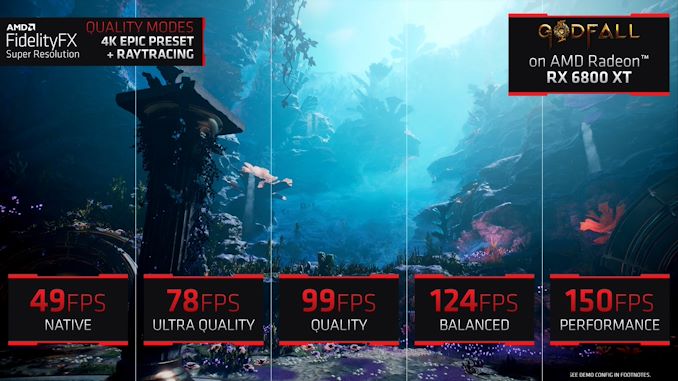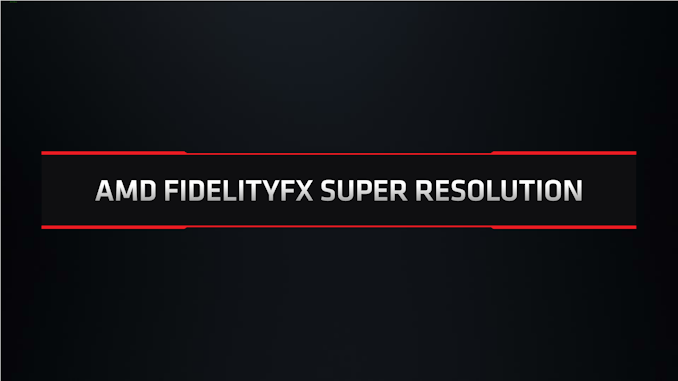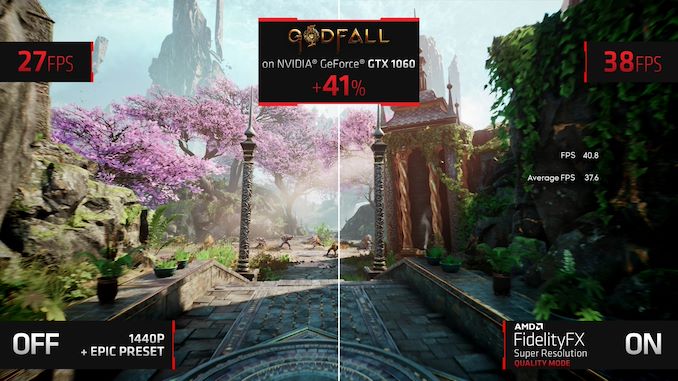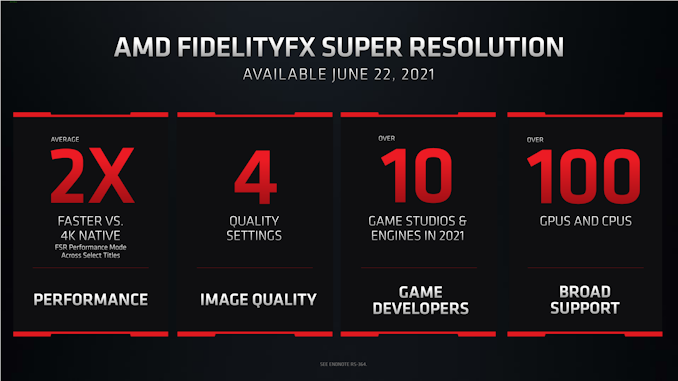AMD Formally Unveils FidelityFX Super Resolution: Open Source Game Upscaling
by Ryan Smith on May 31, 2021 11:00 PM EST
Alongside announcing their new Radeon RX 6000M notebook GPUs, AMD this evening is also using Computex to formally unveil their FidelityFX Super Resolution technology. The game upscaling technology has garnered a lot of interest since AMD first announced last year that they were working on the technology, today AMD is finally lifting the lid on the technology, at least for a brief moment. Overall today is more of a teaser of what’s to come on June 22nd, when AMD is planning to reveal more information on the technology, but for the moment this is the biggest information release on the technology since AMD’s initial announcement.
As a quick recap, AMD announced FidelityFX Super Resolution last year as part of the Radeon RX 6000 series launch. The in-development technology was being designed as AMD’s answer to NVIDIA’s increasingly popular Deep Learning Super Sampling (DLSS) technology, an advanced image upscaling technique NVIDIA introduced to allow their GPUs to render games at a lower resolution (and thus higher performance) without the severe hit to image quality. Research into DLSS and similar smart upscaling techniques has become increasingly intense, as upscaling offer a tantalizing way to improve game performance via what’s computationally a relatively cheap post-processing effect.
While NVIDIA seems to have finally hit their stride with DLSS 2.0, the downside for everyone who is not NVIDIA is that it’s an NVIDIA-only technology. Which for AMD, means it’s yet another NVIDIA value-add software feature that NVIDIA can use to outmaneuver AMD. And while it’s not strictly necessary for AMD to match NVIDIA on a one-for-one software feature basis, clearly DLSS is the start of a bigger shift in the game rendering landscape, so it’s an area where AMD is going to try to catch up, both to nullify an NVIDIA advantage and to give PC game developers another tool in their arsenal for better performance.
And thus FidelityFX Super Resolution was born. While today is more a teaser than a detailed technical breakdown, AMD is confirming a few major facts about their take on smart game upscaling.
First and foremost, FSR, as AMD likes to call it, will be another one of AMD’s GPUOpen technologies, meaning that it will be published open source and free for developers to use. And not only will developers be able to use it on AMD GPUs, but they will be able to use it on NVIDIA GPUs as well.
AMD is not going into the specific technical underpinnings of the execution model here – I’m assuming this is being implemented as a shader – but they are confirming that it doesn’t require any kind of tensor or other deep learning hardware. As a result, the technology can be used not only on recent AMD Radeon RX 6000 series cards, but also the RX 5000 series, RX 500 series, and Vega series. Meanwhile, though it won’t be officially supported to the same extent on NVIDIA cards, according to AMD FSR will work (on day one) on NVIDIA cards going back as far as the Pascal-based GTX 10 series (which pre-dates DLSS support). In fact about the only modern graphics hardware not supported at this point are the current-generation game consoles; AMD may get there one day, but for now they’re focusing on the PC side of things.
At this point AMD is not disclosing which games will support the technology, but the messaging right now is that developers will need to take some kind of an active role in implementing the tech. Which is to say that it’s not sounding like it can simply be applied in a fully post-processing fashion on existing games ala AMD’s contrast adaptive sharpening tech.
Following its June 22nd launch, AMD will be posting FSR to GPUOpen. Overall the company is stating that over 10 “game studios and engines” in 2021 will implement FSR, with more details to come on the 22nd. Expect to see Godfall among these game, as AMD is using it as their example game for today’s announcement.
Moving on, AMD is also revealing that FSR will have four quality modes. Similar to DLSS, I expect that these modes are all based on the upscaling factor used, and that the smaller upscaling factor used (the closer to native resolution you are) the higher the quality mode. Formally, these modes are Ultra Quality, Quality, Balanced, and Performance mode.
For today’s Computex presentation, AMD is publishing performance numbers from Godfall, running on a 6800XT. That card gets 49 fps when running at 4K with the “epic” image quality preset and ray tracing. This rises to 78 fps with FST in ultra quality mode, 99 fps in quality mode, 124 fps in balanced mode, and 150 fps in performance mode. The exact benefit will depend on the card and the game used, of course, but overall AMD is touting the tech’s performance mode as improving game performance by over 2x versus native 4K rendering.

(ed: this slide does not appear to have FSR applied; it’s just a fancy background for the performance data)
However the million dollar question – and the question that AMD won’t really be answering until the 22nd – is what the resulting image quality of FSR will be like. Like other upscaling techniques, FSR will live or die by how clean of an image it produces. Upscaling techniques are going for “good enough” results here, so it doesn’t need to match native quality, however it needs to be enough to produce a reasonably sharp image without serious spatial or temporal artifacts.
And, to drop into op-ed mode, this is where AMD has me a bit worried. In our pre-briefing with AMD, the company did confirm that FSR is going to be a purely spatial upscaling technology; it will operate on a frame-by-frame basis, without taking into account motion data (motion vectors) from the game itself.
For GPU junkies, many of you will recognize this as a similar strategy to how NVIDIA designed DLSS 1.0, which was all about spatial upscaling by using pre-trained, game-specific neural network models. DLSS 1.0 was ultimately a failure – it couldn’t consistently produce acceptable results and temporal artifacting was all too common. It wasn’t until NVIDIA introduced DLSS 2.0, a significantly expanded version of the technology that integrated motion vector data (essentially creating Temporal AA on steroids), that they finally got DLSS as we know it in working order.
Given NVIDIA’s experience with spatial-only upscaling, I’m concerned that AMD is going to repeat NVIDIA’s early mistakes. Spatial is a lot easier to do on the backend – and requires a lot less work from developers – but the lack of motion vector data presents some challenges. In particular, motion vectors are the traditional solution to countering temporal artifacting in TAA/DLSS, which is what ensures that there are no frame-by-frame oddities or other rendering errors from moving objects. Which is not to say that spatial-only upscaling can’t work, only that, if it’s competitive in image quality with DLSS, that would be a big first for AMD.
Unfortunately, AMD isn’t doing themselves any favors in this regard with today’s presentation. Within their slide deck there is a single split image with FSR seemingly enabled, which they use for a GTX 1060 performance comparison. I’ve gone ahead and extracted the raw image from the slide deck given to the press and uploaded it here, to try to preserve as much image quality as possible. (Be sure to click on it to see the full-resolution shot)
Taking a jab at NVIDIA by comparing the GTX 1060 running at 1440p native versus FSR in quality mode, the demonstration slide shows that performance is significantly improved, bringing the GTX 1060 from 27 fps to 38 fps. Unfortunately the image quality hit is quite noticeable here. The building and bridge are blurrier here than the native resolution example, and the tree in the background – which is composed of many fine details – easily gives up the fact that it’s running at a lower resolution.
With that said, as I haven’t seen the technology in person in motion yet, I’m not in a position to claim how good all of this looks in action. But at least for static screenshots, it does raise an eyebrow. Though I will give AMD credit here for publishing a (seemingly honest) screenshot like this, rather than cherry picking something that oversells FSR.
In any case, there’s a lot more technical information on FSR that we’ve yet to see, and which AMD will be presenting on June 22nd. And, given the open source nature of FSR, AMD has little incentive or ability to hold back on technical information for too long. So the questions raised today with their brief teaser will make for good discussion fodder for FSR’s actual launch.
Finally, ahead of the FSR launch AMD is soliciting feedback on what games users would like to see supporting the technology. AMD is preseumably going to use this to help guide their developer relations priorities, so if you're interested in supplying feedback, be sure to stop by AMD's FSR survey site.
Overall, it goes without saying that a lot of people are eager to see what AMD can do with game upscaling technology, both to level the playing field with NVIDIA and to bring it to a wider array of hardware and games. It’s an ambitious project from AMD, and it will undoubtedly be interesting to see how everything falls into place when AMD launches the tech on June 22nd. So be sure to stay tuned for that!













80 Comments
View All Comments
isthisavailable - Monday, May 31, 2021 - link
Love that they used a GTX 1060 in their presentation. A nice slap in the face to Nvidia.at_clucks - Tuesday, June 1, 2021 - link
Comparing to a 2+ year old Nvidia card certainly doesn't do AMD any favors. When you want to show off your latest and greatest pick the best the competitor has.But this tech will go great with all those 1600+Euro 6800XTs. o_O
check0790 - Tuesday, June 1, 2021 - link
It actually does AMD favours. The 1060 wasn't just a random pick, it's currently the most used card as listed in Steam surveys. It's also a card that does not possess any tensor cores or dedicated hardware to process any of this, where NVidias DLSS needs dedicated hardware to run. So by showing that devs can use this regardless of target hardware and current consoles also use AMD hardware, anyone developing multi-platform titles is more likely to support this instead of DLSS.at_clucks - Tuesday, June 1, 2021 - link
Sure but from a branding perspective it suggests they can only fight in *that* range. Perhaps that's what they're interested in, targeting that segment. They still place themselves as a mighty low offering.In contrast, on the CPU launches or announcements they rarely position themselves against old, lower end Intel CPU, no matter how popular those may have been.
AREryilmaz - Tuesday, June 1, 2021 - link
Mate consumers are far more likely to use such a feature on a lower end card rather than an already mighty 6800XT. The 1060 is the perfect choice here. The scaling seems like such that might breathe new life into an already alive and well 1080ti for example.at_clucks - Wednesday, June 2, 2021 - link
Mate, consumers don't buy "the game with FidelityFX Super Resolution". They buy what they're given. Showing that the 5 year old GTX 1060 has the best improvement makes it look like AMD is launching a stopgap solution for GPUs that will get upgraded pretty soon anyway. Maybe the GPU availability black hole keeps going for another couple of years.And to be honest, maybe that's exactly what they're doing. If it's indeed a DLSS 1.0 equivalent (so if that can be used as a reference for performance compared to an eventual follow-up) then it is a stop gap solution, a 1.0, that thing that might keep old mid-range cards from the competitor chugging along through the GPU crisis. No favors there.
What did them some favors is that the tech works with such a wide range of GPUs, including Nvidia's.
at_clucks - Wednesday, June 2, 2021 - link
P.S. The 1080Ti that you mentioned would have been a much better reference. It's still a more than decent card that one could conceivably hang on to for a while longer. Comparing to the 1060 feels like showing improvements on a 2nd gen. i5. Something that's on the edge of being upgraded for most users.Murloc - Tuesday, June 1, 2021 - link
This is an advertisement towards the game developers rather than people who spend lots of money on GPUs. You don't need this technology with a top end GPU.euskalzabe - Saturday, June 5, 2021 - link
You’d think that’s quite obvious, but the commenter you’re responding to doesn’t seem to get it…mode_13h - Sunday, June 6, 2021 - link
> You don't need this technology with a top end GPU.Who wouldn't want better framerates, even *with* a top-end GPU?